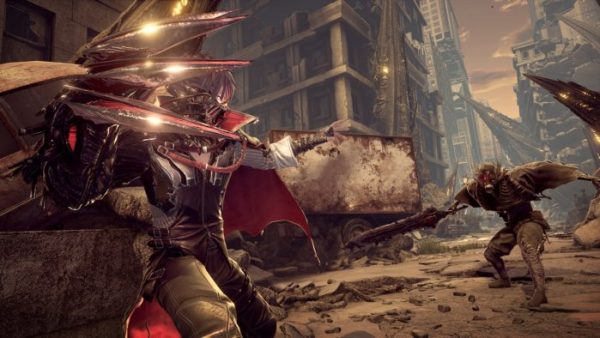Code Vein is the newest title from the developer behind the God Eater series, and since its announcement, it’s drawn some obvious comparisons to the Dark Souls series. It has the same kind of methodical combat, multiple weapon types, character creation, etc. However, there are quite a few systems in Code Vein that set it apart from the competition and provide an interesting wrinkle on the Souls formula. After getting some hands-on time with the game at E3 we found out more about these systems, and even said Code Vein was one of the most promising RPGs of the show.
Partner System

The biggest, and most obvious, difference Code Vein brings is the addition of an AI partner. Most Souls games are a lonesome, tension-filled experience. In Code Vein though, at almost all times you’ll have an AI partner with you, a key character in the story, who helps you in combat and has their own background story.
Each of these partners have their own unique movesets, like the two-handed sword wilder Yakumo who acts as a frontline combatant that can shield you if you need to heal, versus Louis, a balanced character that can use combos to keep the pressure on enemies and easily swap places with you. Not only are these partners useful, they can change your entire strategy in battle and it’s easy to lean on their aid in battles. Of course, this doesn’t mean that you can just let them do all the work, as our time with the demo showed if you just let them take on enemies alone they’ll quickly be slaughtered. If you die, your partner can use a portion of their health to revive you, and you’re able to do the same for your partner.
Code Vein is still a punishingly difficult game, and even in the 25 minutes I played I died multiple times, having to learn how to take on each enemy. The addition of a partner doesn’t change that level of difficulty, but it definitely changes how you approach a Souls-style game.
Blood Codes, Abilities, and “Gifts”

Outside of the various weapons you have access to, Code Vein layers on a ton of different abilities known as “Gifts,” and a sort of class system called “Blood Codes.” In our demo we could only equip one Blood Code, but there was an indication of at least three different codes. Fighter focused on delivering heavy attacks with big weapons, Assassin was focused on combination attacks, and Caster excels at using attack Gifts.
Code Vein is a complex game, and that’s before you layer in the different Gifts, your character’s cloak, passive abilities, and consumables. Gifts are going to be a huge part of your arsenal, and they have a variety of uses like cloaking yourself in a shield that’ll soak up the next attack you take, or coating your weapon in ice. The Gifts you get are specific to your Blood Code, but our demo did state that by beating certain enemies you can become proficient with certain Gifts, letting you equip them regardless of which code you have.
All of these complex systems and layers make Code Vein a bit of a challenge to learn, however, it seems like once you do it’ll be quite rewarding. In just a short amount of time, once I figured out how to use all of my Gifts combat started flowing smoothly.
Faster Pace and Combos

Gifts and abilities tie directly into another vital aspect of Code Vein’s combat, the speed. If I had to compare it, Code Vein feels more akin to Bloodborne than it does Dark Souls, and at least from what I played being aggressive really paid off. In order to use Gifts, you’ll need a resource known as Ichor, which can be gained by draining blood from enemies. Backstabbing enemies results in a ton of Ichor, while parrying and using any ability that has drain also produces some. Mid combo you’re even able to hit R1+X to use a “mid combo drain,” where your character plunges a massive claw into the enemy and drains their blood.
Ichor becomes something that you need to manage, and linking all of the myriad systems together lets you pull of lengthy combos, unlike Dark Souls which is more focused on individual attacks. It’s a constant challenge of juggling your basic attacks, using Gifts, draining enemies, and dodging, and it’s easy to fall into a rhythm with the game’s combat. In an interview with VG247, Code Vein’s director, Hiroshi Yoshimura, commented on the idea of combos in the game saying “There are ways where you watch the enemy’s actions you can wait until after they’ve attacked and use it in their moment of weakness, or you can do something like a combo where you attack and actively create that moment of weakness in order to use the blood veil to suck the enemy’s blood. That’s the kind of combos we’re providing.”
As if all this wasn’t enough there’s another mechanic called Focus, which builds as you’re attacked and take damage. Once your Focus is full you can enter a special “Focus State,” which boosts your defense against attacks and lets you launch enemies into the air with a special move, performing an auto-drain in the process.
Once you combine the abilities of both you and your partner, Code Vein’s battles feel like a much different experience than Dark Souls, even if the core of it is similar.
Art Style and Story

Taking one look at Code Vein shows something strikingly different from Dark Souls, and the game’s anime aesthetic is by far one of its most unique aspects. It still manages to somehow look somewhat like Souls, mixing a heavy Gothic theme with anime visuals and characters. Along with this different aesthetic, however, comes a much larger emphasis on storytelling.
This isn’t to say that Dark Souls didn’t have any story, it had a tone, but the series is well known for the unique, and rather cryptic way it told its story. Flavor text on weapons and items, and random characters you meet through the world are just as, if not more important, than the cutscenes in Dark Souls. Code Vein takes a different path, putting an emphasis on cutscenes and explicit character development. Yoshimura explains this in greater detail in the aforementioned interview, stating ” Yes, it is that… Dark Souls-ish, dungeon action RPG. Because I’m the creator of God Eater, there’s a lot of character behind the story and drama behind the story, too. We do have that unique flavor of narrative in there, so we wanted to feature that within the dungeon action RPG genre.”
Even the recent story trailer released before E3 puts a big emphasis on narrative, and it looks like Code Vein will be sticking to the JRPG style of storytelling, versus the western style Dark Souls went for. Meaning that Code Vein wants to develop a cast of characters with unique personalities, whereas Souls lets you inhabit the shoes of a character that’s basically a cipher for you to interpret and explore the world.
Souls games clearly serve as the inspiration for Code Vein, but Bandai Namco Studios is taking steps to make this one of the most unique imitators yet.
